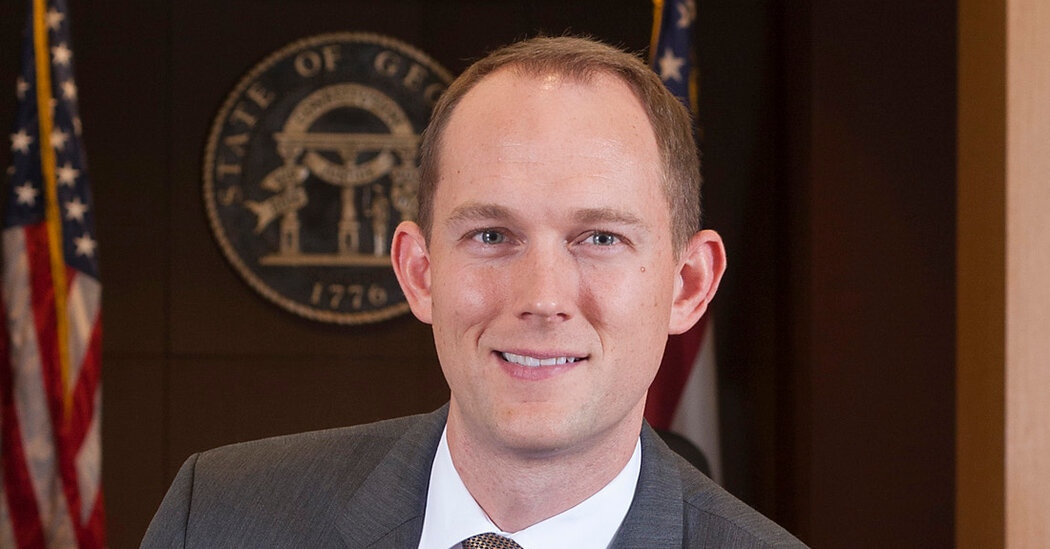How the G.O.P. Molded the Arizona Court That Upheld the Abortion Ban
When a split Arizona Supreme Court upheld a Civil War-era abortion ban this week, it rejected the argument that the 160-year-old statute had been overtaken by decades of newer laws regulating the procedure, including a recent law banning abortion after the 15th week of pregnancy.
But to better understand the court itself, look no further than the year 2016, when Gov. Doug Ducey, a Republican, successfully expanded the court’s membership from five to seven justices.
By the time Mr. Ducey left office at the end of 2022, he had easily eclipsed the state record for judicial appointments to various courts. He had also changed the nominating process by which judges are selected, essentially giving more power to the governor.
And as an ardent conservative who frequently railed against big government and championed restrictions on immigration, he also shaped an all-Republican State Supreme Court into one that had an even more libertarian, prosecutorial and conservative activist bent.
As a result, all four of the justices who were part of the majority decision in the abortion case on Tuesday were appointed by Mr. Ducey, while the two justices who dissented over any attempt to revive the earlier law were appointed by Mr. Ducey’s Republican predecessor, Jan Brewer.
Mr. Ducey’s imprint might have been even more pronounced, had one of his appointees, Justice William G. Montgomery, not recused himself in response to complaints about a 2017 Facebook post in which he said that Planned Parenthood, one of the parties in the case, was “responsible for the greatest generational genocide known to man.”
The four judges behind reviving the abortion ban included Clint Bolick, a nationally known legal activist who helped advance an array of conservative litigation as a co-founder of the Institute for Justice, a right-leaning public interest law firm based in Washington. He oversaw similar cases in Arizona at the conservative Goldwater Institute before being appointed by Mr. Ducey to the Supreme Court in 2016.
“It’s very much a Ducey court,” said Scott Bales, a former chief justice of the Arizona Supreme Court, and a Democrat, who retired in 2019.
With the overturning of Roe v. Wade by the U.S. Supreme Court in 2022, the issue of abortion access has been left in the hands of the states. That has translated into a significant shift in power to courts at the state level, especially in states where the procedure has been limited or banned. Some of them, like Arizona, are dusting off statutes that are decades old for guidance.
And in a presidential election year where abortion is likely to play a prominent role, this new stream of cases has meant that more attention is being paid to the individual justices who now sit on the bench, and how they got there.
Douglas Keith, senior counsel at the Brennan Center for Justice, said that Arizona stood out as “one of the more aggressive and more successful efforts” orchestrated by governors and legislatures to assert more control over states’ higher courts.
“The court’s makeup today is the product of a multiyear effort to lock in a conservative majority on the Arizona Supreme Court, just as the state’s politics were moving to the left,” said Mr. Keith, who is also a founding editor of State Court Report, which examines state constitutions and courts.
But Daniel Scarpinato, a former chief of staff to Mr. Ducey, said it was clear that the court’s ruling this week was based on a close reading of the law, not politics.
“The Arizona system to the greatest degree possible has drained the politics out of the judiciary,” he said. “You’ll never do it completely, but I haven’t seen a system or process that’s better than the one we have.”
The latest ruling has roiled state politics and left politicians of both parties scrambling for legislative remedies ahead of the November elections, a situation that appears to have left even Mr. Ducey with some misgivings.
“The ruling today is not the outcome I would have preferred,” he wrote on X. He encouraged officials “to heed the will of the people and address this issue with a policy that is workable and reflective of our electorate.”
In the past, Arizona’s highest court typically included Republicans and Democrats who had attended law schools in Arizona as well as East Coast institutions like Harvard and Yale. Several had clerked for Supreme Court justices, including Mr. Bales, who clerked for Justice Sandra Day O’Connor, an Arizona native.
Things changed when Mr. Ducey expanded the court. Proponents argued that the courts, in one of the nation’s fastest-growing states, needed more judges to handle a growing caseload. But critics said that the new appointments had allowed the Republican state leadership to expand its influence.
The current court is made up largely of mainstream conservatives, many with backgrounds as prosecutors in Arizona and ties to the Federalist Society, a conservative legal organization that advocates for a close adherence to the text of the U.S. Constitution as it was originally constructed.
Many legal analysts, both liberal and conservative, said there appeared to be a solid legal foundation for Tuesday’s ruling and an attempt to apply the State Legislature’s own recent decisions on the abortion issue.
“I don’t see it as an ideology-driven decision; I think what the majority is saying is, ‘We’re trying to be faithful to what the Arizona Legislature really intended,’” said Barbara Atwood, a law professor at the University of Arizona. “They don’t care what the Legislature intended in 1864. They care what the Legislature intended in 2022.”
Of the seven members of the bench, who face mandatory retirement at age 70, Justice Bolick is probably the only one who is widely known outside Arizona.
Justice Bolick, a 66-year-old political independent, is a conservative libertarian who is “in his own camp” ideologically, said Mr. Scarpinato, who was working in the governor’s office when the appointment was made.
The justice’s vote this week to uphold the 1864 abortion law could signal political trouble for his wife, Shawnna Bolick, a Republican member of the State Senate who was appointed to fill a vacancy and could face a tight battle for election in November. Hours after the ruling on Wednesday, Ms. Bolick called in a post on X for the State Legislature to “find common ground of common sense” and repeal the law.
Justice Montgomery drew fire from liberal critics when he was named to the bench in 2019 over his policies as county attorney and chief prosecutor in Maricopa County, where he was seen as an ally of the divisive former sheriff, Joe Arpaio. The state’s judicial nominating commission rejected his first application to join the court, citing “patterns of misconduct” during his stint as prosecutor, but Mr. Ducey named him to a vacant seat months later after replacing some members of the commission.
The calls for Justice Montgomery to recuse himself from the abortion case cited not only the inflammatory social media post but his pursuit as county attorney of a lawsuit seeking to limit abortions, a case that was rejected by the U.S. Supreme Court in 2013.
Justice John R. Lopez IV, who wrote the majority opinion this week, worked in the U.S. attorney’s office in Phoenix and later as Arizona solicitor general before becoming the first Latino member of the court in 2017. James P. Beene, a former Maricopa County deputy county attorney and state appeals court judge who joined the court in 2019, is the second Latino justice.
Justice Kathryn H. King, one of two women on the court and the only one to uphold the 1864 law, was a top legal aide to Mr. Ducey when he was governor. She worked at two prominent Phoenix law firms before joining the court in 2021.
The two dissenters include the court’s current chief justice, Robert M. Brutinel, 66, and the justice who will succeed him in July, Ann A. Scott Timmer. Chief Justice Brutinel, named to the court in 2010, was a Superior Court judge in deeply conservative Yavapai County whose tenure has brought a marked degree of consensus in the court’s opinions, something he has said he was striving to achieve.
Justice Timmer, who was named to the court in 2012, previously spent a dozen years on the state Court of Appeals, including three years as chief judge.
Arizona is one of roughly 20 states where judges must face the voters to keep their jobs.
Under the system, voters must decide to retain or reject judges two years after their appointments, and every six years after that. Of 1,500 judges who have gone through the process since the mid-1970s, only six have lost — and three of those losses occurred in 2022.
No Supreme Court justice has lost, but Justice Montgomery came close, in 2022, garnering 55 percent of the vote. Republican legislators, who control the statehouse, are now considering a proposal to make it more difficult to remove Supreme Court justices except in extraordinary circumstances.
The two members of the court who face retention elections this year are Justice Bolick and Justice King.
Given the likelihood that Arizona voters will already be weighing a ballot initiative to enshrine the right to an abortion in the Constitution, those judicial races may well attract more attention than usual, said Paul Weich, a lawyer who writes the newsletter Arizona’s Law. “I would anticipate that the abortion access initiative coalition is going to be urging people to not only vote for the initiative but to vote for no on retention for those two justices.”
Kirsten Noyes contributed research.


